
Coprinus is a small genus of mushroom-forming fungi consisting of Coprinus comatus—the shaggy ink cap (British) or shaggy mane (American)—and several of its close relatives. Until 2001, Coprinus was a large genus consisting of all agaric species in which the lamellae autodigested to release their spores. The black ink-like liquid this creates gave these species their common name "ink cap" (British) or "inky cap" (American).

Coprinus comatus, commonly known as the shaggy ink cap, lawyer's wig, or shaggy mane, is a common fungus often seen growing on lawns, along gravel roads and waste areas. The young fruit bodies first appear as white cylinders emerging from the ground, then the bell-shaped caps open out. The caps are white, and covered with scales—this is the origin of the common names of the fungus. The gills beneath the cap are white, then pink, then turn black and deliquesce ('melt') into a black liquid filled with spores. This mushroom is unusual because it will turn black and dissolve itself in a matter of hours after being picked or depositing spores.

Amanita gemmata, commonly known as the gemmed amanita or the jonquil amanita, is an agaric mushroom of the family Amanitaceae and genus Amanita. The fruit body has a cap that is a dull to golden shade of yellow, and typically 2.5–12 centimetres in diameter. The cap surface is sticky when moist, and characterized by white warts, which are easily detached. It is initially convex, and flattens out when mature. The flesh is white and does not change colour when cut. The gills are white and closely spaced. The stem is pale yellow, and measures 4–12 cm long by 0.5–1.9 cm thick. The partial veil that covers the young fruit body turns into the ring on the stem at maturity. The spore print is white. It resembles numerous other species.

Coprinopsis atramentaria, commonly known as the common ink cap, tippler's bane, or inky cap, is an edible mushroom found in Europe and North America. Previously known as Coprinus atramentarius, it is the second best known ink cap and previous member of the genus Coprinus after C. comatus. It is a widespread and common fungus found throughout the northern hemisphere. Clumps of mushrooms arise after rain from spring to autumn, commonly in urban and disturbed habitats such as vacant lots and lawns, as well as grassy areas. The grey-brown cap is initially bell-shaped before opening, after which it flattens and disintegrates. The flesh is thin and the taste mild. It can be eaten, but due to the presence of coprine within the mushroom, it is poisonous when consumed with alcohol, as it heightens the body's sensitivity to ethanol in a similar manner to the anti-alcoholism drug disulfiram.

Neolentinus ponderosus, commonly known as the giant sawgill, or ponderous lentinus, is a species of fungus in the family Gloeophyllaceae. Found in western North America, it was originally described in 1965 as a species of Lentinus by American mycologist Orson K. Miller.

Hydnellum peckii is a fungus in the genus Hydnellum of the family Bankeraceae. It is a hydnoid species, producing spores on the surface of vertical spines or tooth-like projections that hang from the undersurface of the fruit bodies. It is found in North America, Europe, and was recently discovered in Iran (2008) and Korea (2010). Hydnellum peckii is a mycorrhizal species, and forms mutually beneficial relationships with a variety of coniferous trees, growing on the ground singly, scattered, or in fused masses.

Crepidotus versutus, commonly known as the evasive agaric, is a species of fungus in the family Crepidotaceae. It is saprobic on wood, like other Crepidotus species, but it can also decompose herbaceous forest litter. The species is characterized by large, punctate, ellipsoid spores, and the white, hairy pileus.

Coprinopsis lagopus is a species of fungus in the family Psathyrellaceae. Until 2001, the species was known as Coprinus lagopus; advances in the understanding of phylogenetic relationships between the various coprinoid species led to a major reorganization of that genus. It is a delicate and short-lived fungus, the fruit bodies lasting only a few hours before dissolving into a black ink – a process called deliquescence. The vague resemblance of the young fruit body to the paw of a white rabbit has earned this species the common name harefoot mushroom.

Coprinellus micaceus, commonly known as the mica cap, glistening inky cap, or shiny cap, is a common species of mushroom-forming fungus in the family Psathyrellaceae with a cosmopolitan distribution. The fruit bodies of the saprobe typically grow in clusters on or near rotting hardwood tree stumps or underground tree roots. Depending on their stage of development, the tawny-brown mushroom caps may range in shape from oval to bell-shaped to convex, and reach diameters up to 3 cm. The caps, marked with fine radial or linear grooves that extend nearly to the center, rest atop whitish stipes up to 10 cm (4 in) long. In young specimens, the entire cap surface is coated with a fine layer of reflective mica-like cells. Although small and with thin flesh, the mushrooms are usually bountiful, as they typically grow in dense clusters. A few hours after collection, the gills will begin to slowly dissolve into a black, inky, spore-laden liquid—an enzymatic process called autodigestion or deliquescence. The fruit bodies are edible before the gills blacken and dissolve, and cooking will stop the autodigestion process.
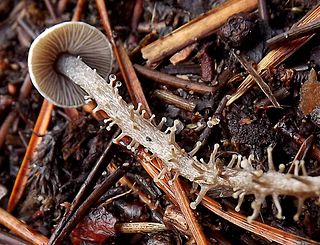
Dendrocollybia is a fungal genus in the family Tricholomataceae of the order Agaricales. It is a monotypic genus, containing the single species Dendrocollybia racemosa, commonly known as the branched collybia or the branched shanklet. The somewhat rare species is found in the Northern Hemisphere, including the Pacific Northwest region of western North America, and Europe, where it is included in several Regional Red Lists. It usually grows on the decaying fruit bodies of other agarics—such as Lactarius and Russula—although the host mushrooms may be decayed to the point of being difficult to recognize.
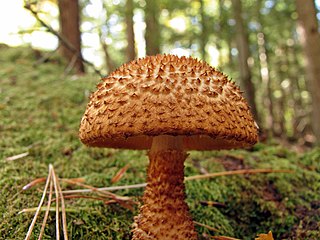
Leucopholiota decorosa is a species of fungus in the mushroom family Tricholomataceae. Commonly known as the decorated pholiota, it is distinguished by its fruit body which is covered with pointed brown, curved scales on the cap and stem, and by its white gills. Found in the eastern United States, France, and Pakistan, it is saprobic, growing on the decaying wood of hardwood trees. L. decorosa was first described by American mycologist Charles Horton Peck as Agaricus decorosus in 1873, and the species has been transferred to several genera in its history, including Tricholoma, Tricholomopsis, Armillaria, and Floccularia. Three American mycologists considered the species unique enough to warrant its own genus, and transferred it into the new genus Leucopholiota in a 1996 publication. Lookalike species with similar colors and scaly fruit bodies include Pholiota squarrosoides, Phaeomarasmius erinaceellus, and Leucopholiota lignicola. L. decorosa is considered an edible mushroom.
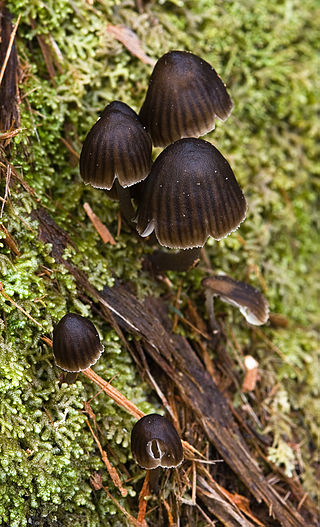
Mycena nargan, commonly known as the Nargan's bonnet, is a species of fungus in the family Mycenaceae, and the sole member of the section Nargan in the genus Mycena. Reported as a new species in 1995, it is known predominantly from Southern Australia. The saprobic fungus produces mushrooms that grow on well-decayed wood, often on the underside of wood lying in litter. The dark chestnut-coloured caps are covered with white, easily removed scales, and reach diameters of up to 2 cm (0.8 in) wide. The pale, slender stems are up to 5 cm (2.0 in) long and have white scales at the base. On the underside of the cap, the cream-coloured gills are widely spaced and bluntly attached to the stem. The edibility of the mushroom is unknown.

Mycena overholtsii, commonly known as the snowbank fairy helmet or fuzzy foot, is a species of fungus in the family Mycenaceae. The mushrooms produced by the fungus are relatively large for the genus Mycena, with convex grayish caps up to 5 cm (2 in) in diameter and stems up to 15 cm (6 in) long. The gills on the underside of the cap are whitish to pale gray, and initially closely spaced before becoming well-spaced at maturity after the cap enlarges. The mushrooms are characterized by the dense covering of white "hairs" on the base of the stem. M. overholtsii is an example of a snowbank fungus, growing on well-decayed conifer logs near snowbanks, during or just after snowmelt. Formerly known only from high-elevation areas of western North America, particularly the Rocky Mountain and Cascade regions, it was reported for the first time in Japan in 2010. The edibility of the mushroom is unknown. M. overholtsii can be distinguished from other comparable species by differences in location, or spore size.

Amanita bisporigera is a deadly poisonous species of fungus in the family Amanitaceae. It is commonly known as the eastern destroying angel amanita, the eastern North American destroying angel or just as the destroying angel, although the fungus shares this latter name with three other lethal white Amanita species, A. ocreata, A. verna and A. virosa. The mushroom has a smooth white cap that can reach up to 10 centimetres across and a stipe up to 14 cm tall with a white skirt-like ring near the top. The bulbous stipe base is covered with a membranous sac-like volva. The white gills are free from attachment to the stalk and crowded closely together. As the species name suggests, A. bisporigera typically bears two spores on the basidia, although this characteristic is not immutable. A. bisporigera closely resembles a few other white amanitas, including the equally deadly A. virosa and A. verna.

Lactifluus deceptivus, commonly known as the deceiving milkcap, is a common species of fungus in the family Russulaceae. It is found throughout eastern North America on the ground in coniferous forests near hemlock or deciduous forests near oak, and in oak-dominated forests of Costa Rica. It produces large mushrooms with funnel-shaped caps reaching up to 25 cm (9.8 in) in diameter, on top of hard white stems that may reach 4–10 cm (1.6–3.9 in) long and up to 3 cm (1.2 in) thick. The gills are closely spaced together and yellowish-cream in color. When young, the cap is white in all parts, but the depressed center becomes dull brownish in age and breaks up into scales. The edge of the cap has a roll of cottony tissue that collapses as the cap expands. The surface of the stem—especially near the base—has a velvety texture. The mushroom "bleeds" a milky white acrid latex when it is cut or injured. Similar milk-cap species with which L. deceptivus might be confused include Lactifluus piperatus, L. pseudodeceptivus, L. caeruleitinctus, L. subvellereus, Lactarius arcuatus and Lactarius parvulus.

Tulosesus impatiens is a species of fungus in the family Psathyrellaceae. First described in 1821, it has been classified variously in the genera Psathyrella, Pseudocoprinus, Coprinarius, and Coprinus, before molecular phylogenetics reaffirmed it as a Coprinellus species in 2001. The fungus is found in North America and Europe, where the mushrooms grow on the ground in deciduous forests. The fruit bodies have buff caps that are up to 4 cm (1.6 in) in diameter, held by slender whitish stems that can be up to 10 cm (3.9 in) tall. Several other Coprinopsis species that resemble C. impatiens may be distinguished by differences in appearance, habit, or spore morphology.
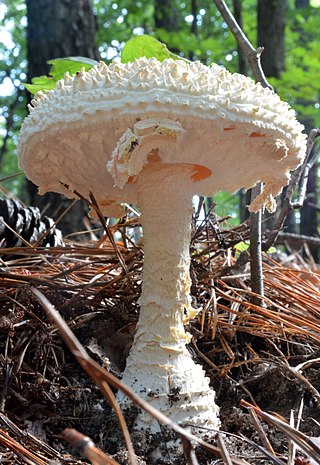
Amanita ravenelii, commonly known as the pinecone lepidella, is a species of fungus in the family Amanitaceae. The whitish fruit bodies are medium to large, with caps up to 17 centimetres wide, and stems up to 25 cm (10 in) long. The cap surface has large warts and the stem has a scaly, bulbous base. The mushrooms have a unique chlorine like odor.
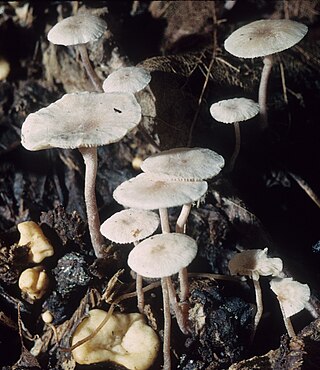
Collybia cookei is a species of fungus in the family Tricholomataceae, and one of three species in the genus Collybia. It is known from Europe, Asia, and North America. The fungus produces fruit bodies that usually grow on the decomposing remains of other mushrooms, like Meripilus giganteus, Inonotus hispidus, or species of Russula; occasionally fruit bodies are found on rich humus or well-decayed wood. The fungus produces small white mushrooms with caps up to 9 mm (0.35 in) in diameter, supported by thin stems that originate from a yellowish-brown sclerotium. The mushroom is difficult to distinguish from the other two species of Collybia unless an effort is made to examine the sclerotia, which is usually buried in the substrate. The edibility of the mushroom has not been determined.

Parasola auricoma is a species of agaric fungus in the family Psathyrellaceae. First described scientifically in 1886, the species is found in Europe, Japan, and North America. The mushroom was reported in February 2019 in Colombia, in the city of Bogota by the mycologist Juan Camilo Rodriguez Martinez. The small, umbrella-shaped fruit bodies (mushrooms) of the fungus grow in grass or woodchips and are short-lived, usually collapsing with age in a few hours. The caps are up to 6 cm (2.4 in) wide, initially elliptical before flattening out, and colored reddish-brown to greyish, depending on their age and hydration. They are pleated with radial grooves extending from the center to the edge of the cap. The slender, whitish stems are up to 12 cm (4.7 in) long and a few millimeters thick. Microscopically, P. auricoma is characterized by the presence of setae in its cap cuticle. This characteristic, in addition to the relatively large, ellipsoid spores can be used to distinguish it from other morphologically similar Parasola species.

Coprinopsis radiata, formerly known as Coprinus radiatus, and commonly known as the miniature woolly inky cap, is a coprophilous fungus that grows on herbivore dung. It is heterothallic.























